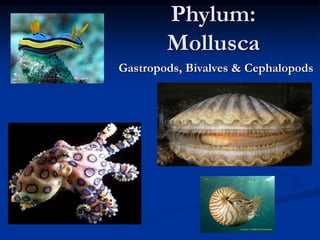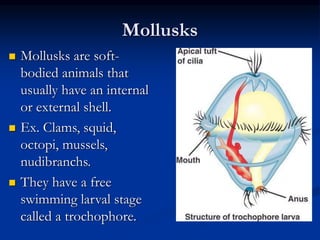Molluska powerpoint.pptx
- 1. Phylum: Mollusca Gastropods, Bivalves & Cephalopods
- 2. Mollusks ïŪ Mollusks are soft- bodied animals that usually have an internal or external shell. ïŪ Ex. Clams, squid, octopi, mussels, nudibranchs. ïŪ They have a free swimming larval stage called a trochophore.
- 3. Body Plan â 4 parts ïŪ 1. foot â used for crawling, burrowing and tentacles ïŪ 2. mantle â thin layer of tissue that covers organs ïŪ 3. shell â made by glands in the mantle that secrete calcium carbonate ïŪ 4. visceral mass â guts. (internal organs)
- 4. Feeding ïŪ Feeding â radula â ribbon of teeth ïŪ Others are filter feeders using an incurrent and excurrent siphon
- 5. Respiration and Circulation ïŪ Respiration â gills ïŪ Circulation - Open circulatory system â heart and open sinuses. Open works for slow moving creatures ïŪ Closed circulatory system â blood is contained in veins and arteries. Octopi and squid
- 6. Response/Movement/Reproduction ïŪ Response- Clams- simple nervous system/eyespot ïŪ Octopi â brains, complex behavior. Octopi and squid can open jars for reward or to avoid punishment ïŪ Movement â mucus with the foot/muscle or jet propulsion for the octopus. ïŪ Reproduction â usually external fertilization in the water. Some tentacled mollusks do internal fertilization. Some can be hermaphrodites.
- 7. 3 main groups of Mollusks ïŪ 1. Gastropods â shell-less or single shelled mollusks that move by using a muscular foot. ïŪ Ex. Sea hares â can squirt ink at predators ïŪ Nudibranches â sea slugs, have chemicals in their bodies that taste bad. Can recycle nematocysts from cnidarians they eat.
- 8. 3 main groups of Mollusks ïŪ 2. Bivalves â two shells held together by two powerful muscles. ïŪ Ex. Clams, oysters, mussels and scallops. Scallops can flap their shells to move when threatened. Filter water over gills use mucus and cilia on gills to trap food particles.
- 9. 3 Main Groups of Mollusks ïŪ 3. Cephalopods â âhead-footedâ . Soft bodied. The head is attached to a single foot. The foot is divided into tentacles or arms. ïŪ Example: squid, octopus, nautilus, cuttlefish. They move by jet propulsion. Many have an ink sac to distract potential predators. ïŪ They have a pen for a âbackbone.â









